Refine search
Actions for selected content:
154 results
Assessing Defence in Late Antique North-eastern Gaul and the Germanic Provinces c. a.d. 250–500: Biases, Distribution and Chronology
-
- Journal:
- Britannia , First View
- Published online by Cambridge University Press:
- 07 November 2025, pp. 1-23
-
- Article
-
- You have access
- Open access
- HTML
- Export citation
Chapter 9 - Imperial and Episcopal Leadership Networks in the Later Roman Empire
-
-
- Book:
- Leadership in the Ancient World
- Published online:
- 14 September 2025
- Print publication:
- 16 October 2025, pp 201-222
-
- Chapter
- Export citation
Introduction
-
- Book:
- God, Slavery, and Early Christianity
- Published online:
- 19 September 2025
- Print publication:
- 09 October 2025, pp 1-47
-
- Chapter
- Export citation
Out of the Temples and into the Streets: Reassembling the Christianisation of Roman Urban Space
-
- Journal:
- Antichthon , First View
- Published online by Cambridge University Press:
- 03 October 2025, pp. 1-25
-
- Article
-
- You have access
- Open access
- HTML
- Export citation
Chapter 1 - Travel Writing in Late Antiquity
- from Part I - Contexts
-
-
- Book:
- The Cambridge Guide to Global Medieval Travel Writing
- Published online:
- 03 October 2025
- Print publication:
- 02 October 2025, pp 21-39
-
- Chapter
- Export citation
Urban Spatiality, Honorific Statuary, and the Celebration of Aristocratic Power in the Late Roman Empire
-
- Journal:
- Antichthon , First View
- Published online by Cambridge University Press:
- 18 September 2025, pp. 1-23
-
- Article
- Export citation
A unique scene of fire worship from the late Sogdian palace at Sanjar-Shah
-
- Journal:
- Antiquity , First View
- Published online by Cambridge University Press:
- 27 August 2025, pp. 1-7
-
- Article
-
- You have access
- Open access
- HTML
- Export citation
Local Patterns of Relic Veneration in Late Antiquity: Reassessing Alleged Distinctions between Greek and Roman Customs
-
- Journal:
- Church History , First View
- Published online by Cambridge University Press:
- 27 August 2025, pp. 1-21
-
- Article
- Export citation
A late-antique catacomb in Sirte: a reassessment of the evidence a century after its excavation
-
- Journal:
- Libyan Studies , First View
- Published online by Cambridge University Press:
- 27 August 2025, pp. 1-7
-
- Article
-
- You have access
- Open access
- HTML
- Export citation
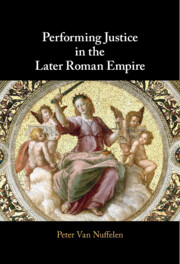
Performing Justice in the Later Roman Empire
-
- Published online:
- 07 August 2025
- Print publication:
- 21 August 2025
Introduction
-
- Book:
- The Cambridge Encyclopaedia of Late Antique Art and Archaeology
- Published online:
- 04 July 2025
- Print publication:
- 31 July 2025, pp 1-6
-
- Chapter
- Export citation
Introduction
-
-
- Book:
- The Cambridge Companion to Christian Heresy
- Published online:
- 17 July 2025
- Print publication:
- 31 July 2025, pp 1-14
-
- Chapter
- Export citation
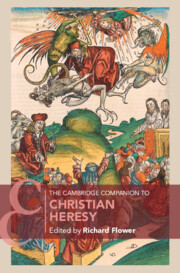
The Cambridge Companion to Christian Heresy
-
- Published online:
- 17 July 2025
- Print publication:
- 31 July 2025

Magic and Heresy in Ancient Christian Literature
-
- Published online:
- 16 July 2025
- Print publication:
- 07 August 2025
-
- Element
- Export citation
Epilogue
- from Part II - Aelius Aristides’ Lyric
-
- Book:
- Aelius Aristides and the Poetics of Lyric in Imperial Greek Culture
- Published online:
- 01 May 2025
- Print publication:
- 15 May 2025, pp 270-275
-
- Chapter
- Export citation
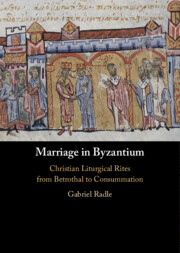
Marriage in Byzantium
- Christian Liturgical Rites from Betrothal to Consummation
-
- Published online:
- 01 May 2025
- Print publication:
- 23 January 2025
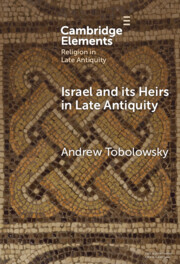
Israel and its Heirs in Late Antiquity
-
- Published online:
- 08 April 2025
- Print publication:
- 08 May 2025
-
- Element
- Export citation
Late Antiquity, post-modernity, and Islam: the 1970s as a point of departure and retrospection
-
- Journal:
- Byzantine and Modern Greek Studies / Volume 49 / Issue 1 / April 2025
- Published online by Cambridge University Press:
- 27 March 2025, pp. 22-28
- Print publication:
- April 2025
-
- Article
-
- You have access
- Open access
- HTML
- Export citation

The Pottery Industries of the Roman East
- Craft Communities and Working Practices
-
- Published online:
- 20 March 2025
- Print publication:
- 03 April 2025
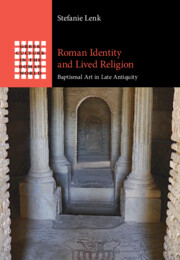
Roman Identity and Lived Religion
- Baptismal Art in Late Antiquity
-
- Published online:
- 08 February 2025
- Print publication:
- 20 February 2025
